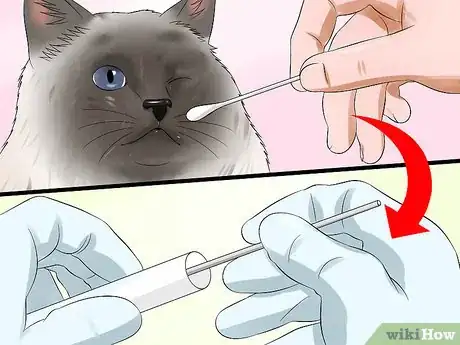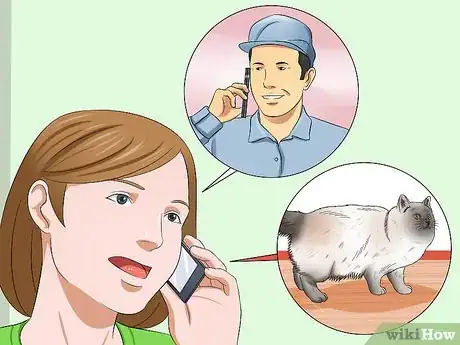This article was co-authored by Pippa Elliott, MRCVS. Dr. Elliott, BVMS, MRCVS is a veterinarian with over 30 years of experience in veterinary surgery and companion animal practice. She graduated from the University of Glasgow in 1987 with a degree in veterinary medicine and surgery. She has worked at the same animal clinic in her hometown for over 20 years.
There are 7 references cited in this article, which can be found at the bottom of the page.
wikiHow marks an article as reader-approved once it receives enough positive feedback. In this case, 82% of readers who voted found the article helpful, earning it our reader-approved status.
This article has been viewed 65,760 times.
With beautiful blue eyes and a calm disposition, the Birman cat is a sought after breed. Arriving in the United States sometime in the mid-twentieth century, it quickly took hold as a favorite of cat enthusiasts and joyful pet addition. If you want a Birman cat, you'll need to know its identifying characteristics, what to look for, and how to make sure you're making an authentic purchase.
Steps
Recognizing a Birman Cat
-
1Look for common Birman cat fur colors. Birman cats are known as color-point cats, and are born fully white with pink noses.They are known as pointed cats because the majority of their coloration will be at "points," like their face, ear, legs, and tail. Their color patterns will emerge as they grow, and can be diverse. [1]
- Their traditional coat colors are seal or blue point but can also be found in: Red pointed, Seal Tabby (Lynx) point, Blue point, Blue Tortie, Chocolate Point, Lilac Tabby (Lynx), and Seal Tortie Tabby.
-
2Look for a single layered coat. Unlike most cats who have double coats, a Birman only have a single layer coat. This will make their fur slightly lighter and softer to the touch with a ruff of fur around their neck.Advertisement
-
3Examine their paws carefully. While Birman cat colors can be similar to other cats, their white paws, really make them stand out. All Birmans will have four white paws that almost appear like gloves. The myths about the Birman cat's origins make a point to say the white paws remained so as a sign of their purity.[2]
- If you plan on showing your cat, make sure the paws are fully white and as symmetrical as possible.
- This is also a way to tell the Birman apart from other pointed cats, like the Siamese cat. While they may have similar color patterns, the Siamese or Persian will not have the starkly white paws.
-
4Take note of the cat's size. Birman's are an average sized cat. They generally range from 7-12 pounds with females being on the smaller end of this range. They are approximately two and a half feet in length and their height should be 12-16 inches. They are considered a medium to large cat.[3]
- If you are looking at kittens, this can be more difficult. However, most reputable breeders will allow access to the parent where you can better gauge the potential adult size of your kitten.
-
5Look closely at the eyes and head. While the white paws are a distinctive feature of the Birman cat, so are its deep blue eyes. The ideal eye color is a deep sapphire blue.
- Birman cats should have a rounded face, medium ears and a "Roman nose," which will give them a pleasant looking disposition.
-
6Observe their behavior and personality. Over the years, purebred Birman cats have been selectively bred for a mellow disposition and to weed out any aggressive tendencies. Birman cats are quiet and have a chirp like meow. They are typically mellow, gentle, and sociable. They are very patient and gentle which makes them a great choice for a family or kid. [4]
- They are very social cats so be prepared for a cat that will require a fair amount of attention and want to be near you often. Many people compare them to dogs for how attached they become to their owners.[5]
- If they are kept with other breeds, they can sometimes act dominant.
Making Sure Your Purchase is Authentic
-
1Ask for pedigree papers. Cats like the Birman that are more exclusive and expensive than the typical cat should come with some sort of paper validation affirming their pedigree. Various associations offer pedigree papers that demonstrate the cat's line. For Birman cats, choose a breeder whose cats are registered with a cat registry, particularly one that specializes in Birmans.[6]
- You should also be careful of putting too much stock in this, as some kitten mills can purchase papers that do not necessarily reflect the cat's lineage. You can inquire into the breeders history breeding Birmans and to meet the parents to put yourself more at ease.
-
2Get a DNA test. Even more certain than papers are scientific DNA tests. This may sound complicated and expensive but is both common and affordable for a prospective cat owner. Choose a reputable DNA testing service, particularly one backed by a university or your vet.[7]
- These tests are typically over 90% accurate.
- You will only need to obtain a cotton swab sample from your cat's cheek and follow protocol and send it to the lab for testing. In exchange, they should be able to give you a full report that gives the cat's parentage. This can be done to kitten as well as adults, as your cat's DNA will never change.[8]
-
3Be weary of where you get your kitten. Especially with more expensive breeds, kitten mills that attempt to sell non-pedigree cats can be a problem. Make sure that you get to see where the kittens were raised, meet the parents if possible and inquire into their experience as a breeder.
- Be cautious of deals that seem too good to be true. Although the price of Birman cats can vary considerably based on where you are, you can expect to pay more than a typical cat, and sometimes several hundreds of dollars, depending on the pedigree. If there are Birman cats available for a price that seems too good to be true, inquire with the seller the reasons behind the low asking price.
Finding a Birman Cat
-
1Do a search on the Internet for "Birman" cats. This can help you find any breeders in your area or groups dedicated to the breed that may point you in the right direction.
-
2Contact local animal shelters. Shelters usually have an over abundance of kittens and cats. Although they are not usually purebred cats, there is a chance that you could stumble upon a Birman if you know how to recognize one.
-
3Contact a breeders association. This is a sure way to make sure you are getting a reputable stock of Birman. A great example of this is the The International Cat Association (TICA) who's website includes breeder listings and criteria to look for on your own. They also have information on exhibitions and shows where you can get into contact with Birman breeders. [9]
Expert Q&A
-
QuestionHow long do Birman cats usually live?
 Pippa Elliott, MRCVSDr. Elliott, BVMS, MRCVS is a veterinarian with over 30 years of experience in veterinary surgery and companion animal practice. She graduated from the University of Glasgow in 1987 with a degree in veterinary medicine and surgery. She has worked at the same animal clinic in her hometown for over 20 years.
Pippa Elliott, MRCVSDr. Elliott, BVMS, MRCVS is a veterinarian with over 30 years of experience in veterinary surgery and companion animal practice. She graduated from the University of Glasgow in 1987 with a degree in veterinary medicine and surgery. She has worked at the same animal clinic in her hometown for over 20 years.
Veterinarian The average life expectancy for a Birman is 12-16 years. You can help a cat reach an older age by feeding life stage diets (for example, feeding cats aged 8 years or over a senior food) which put less strain on the aging kidney.
The average life expectancy for a Birman is 12-16 years. You can help a cat reach an older age by feeding life stage diets (for example, feeding cats aged 8 years or over a senior food) which put less strain on the aging kidney. -
QuestionAre Birman cats friendly?
 Pippa Elliott, MRCVSDr. Elliott, BVMS, MRCVS is a veterinarian with over 30 years of experience in veterinary surgery and companion animal practice. She graduated from the University of Glasgow in 1987 with a degree in veterinary medicine and surgery. She has worked at the same animal clinic in her hometown for over 20 years.
Pippa Elliott, MRCVSDr. Elliott, BVMS, MRCVS is a veterinarian with over 30 years of experience in veterinary surgery and companion animal practice. She graduated from the University of Glasgow in 1987 with a degree in veterinary medicine and surgery. She has worked at the same animal clinic in her hometown for over 20 years.
Veterinarian Birman cats are friendly, but not in an overly needy way. They love to be around people and play, but on their terms. However, as with any animal, socialization in early life is vital, and kittens that were raised in isolation (such as in a run or kennel) will be less well-adjusted and less friendly.
Birman cats are friendly, but not in an overly needy way. They love to be around people and play, but on their terms. However, as with any animal, socialization in early life is vital, and kittens that were raised in isolation (such as in a run or kennel) will be less well-adjusted and less friendly. -
QuestionWhat are Birman cats like?
 Pippa Elliott, MRCVSDr. Elliott, BVMS, MRCVS is a veterinarian with over 30 years of experience in veterinary surgery and companion animal practice. She graduated from the University of Glasgow in 1987 with a degree in veterinary medicine and surgery. She has worked at the same animal clinic in her hometown for over 20 years.
Pippa Elliott, MRCVSDr. Elliott, BVMS, MRCVS is a veterinarian with over 30 years of experience in veterinary surgery and companion animal practice. She graduated from the University of Glasgow in 1987 with a degree in veterinary medicine and surgery. She has worked at the same animal clinic in her hometown for over 20 years.
Veterinarian Birman's are easy-going types that love company but aren't too needy. They have some dog-like qualities, such as enjoying a game of chase. Plus they like the company of other pets, be that another cat or even a dog.
Birman's are easy-going types that love company but aren't too needy. They have some dog-like qualities, such as enjoying a game of chase. Plus they like the company of other pets, be that another cat or even a dog.
References
- ↑ http://cats.wikia.com/wiki/Birman
- ↑ http://cattime.com/cat-breeds/birman-cats
- ↑ http://cattime.com/cat-breeds/birman-cats
- ↑ http://cfa.org/Breeds/BreedsAB/Birman.aspx
- ↑ http://birmanbreed.net/temperament--personality.html
- ↑ http://life.familyeducation.com/cats/pets/45684.html
- ↑ https://www.vgl.ucdavis.edu/services/cat/ancestry/faq.php#3
- ↑ https://www.vgl.ucdavis.edu/services/cat/ancestry/faq.php#3
- ↑ http://www.tica.org/find-a-breeder/item/235-birman-breeders
About This Article
To identify Birman cats, look at your cat’s fur colors since Birmans are born fully white with pink noses. Then, they gain patches of color on their face, ear, legs, and tail. Additionally, feel your cat's coat since Birman's have fur that's light and soft to the touch. You can also check your cat’s paws, which should all be white, and its eyes, which would be a deep blue for a Birman. For more tips from our Veterinary co-author, including how to know if your cat is a Birman based on its behavior, keep reading!









































































